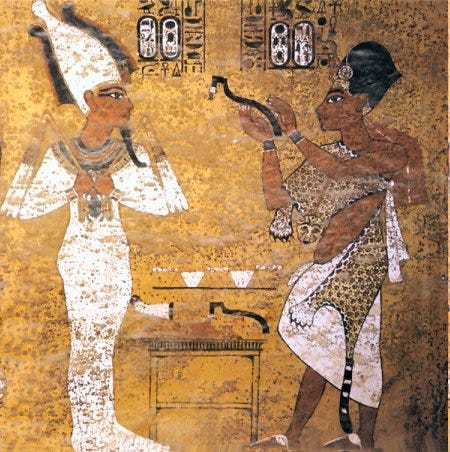Ay and Horemheb: The Powers behind Tutankhamun
When a young king takes over the throne there are always those who seek to take advantage...Grand Vizier Ay was no exception.
Since the discovery of Tutankhamun’s tomb by Howard Carter in 1922, the world has been fascinated with the boy king. Artifacts from his tomb have travelled the globe as audiences flock to see his treasures. Whilst many will immediately recognise Tutankhamun by his now iconic death mask, much of his reign remains a mystery. What we do know though is the influence of those who advised and supported him.
Ascending to the throne following the death of Akhenaten, Tutankhamun would have been thrust into power with little knowledge of the bureaucratic, political, and diplomatic nature of ruling. Thankfully, he was surrounded by those who understood the politics of power. One such individual was his new Grand Vizier, Ay.
Ay was no stranger to the intricate nature of governance. He served in the same role under Akhenaten overseeing the sweeping changes he wanted to make. From turning into Egypt in a monotheist religion that worshipped the Aten (Sun God), to moving the state capital from Thebes to Amarna. Under Akhenaten, Ay was a loyal Grand Vizier who carried out the orders of the Pharaoh. Following his death, with a young boy now on the Throne, Ay could use his experience to make his own changes.
With the young Tutankhamun under his control, Ay was quick to suggest reversing the boy king’s father's legacy. First would be a name change for the new Pharaoh. Tutankhaten was the name originally given by his father. This was to ensure Akhenaten’s legacy through his son and cemented his idea of monotheism religion. Tutankhaten was changed to Tutankhamun in order to embody the religious change about to sweep the country yet again. Despite Ay following the commands of Akhenaten, the change of regime allowed Ay to recommend reverting back to the previous religious ideas and the traditional gods. Ay was also influential in moving the capital back to Thebes.

For now, Ay had the Pharaoh's ear and used his influence well but Tutankhamun also placed his trust in someone else. Horemheb rose to the role of Chief Commander of the Army under Tutankhamun. In this role, Horemheb solidified Egypt's influence in the Middle East. His reward would see Tutankhamun bestow the title of “iry-pat” on Horemheb. This was a disaster for Ay as this now meant that it would be Horemheb that would succeed Tutankhamun in the event that he produced no heirs.
Soon the two men would play a political game against each other as Tutankhamun died prematurely leaving no heir. By rights, the position should have gone to Horemheb but Ay had other ideas. The unexpected death of Tutankhamun meant that time was of the essence in order to prepare his body and complete his tomb. With Horemheb away from the country with the army, Ay had the perfect opportunity to seize the throne from his rival.
Ay would perform the Opening of the Mouth Ceremony on Tutankhamun. The ancient Egyptians believed that in order for a person's soul to survive in the afterlife it would need to have food and water. The opening of the mouth ritual was thus performed so that the person who died could eat and drink again in the afterlife. In many royal tombs, the artwork often showed the new Pharaoh performing the ritual on his predecessor. In Tutankhamun's Tomb, we see Ay performing the sacred ceremony. This shows us not only how the ritual was performed but also that Ay saw himself as Tutankhamun's natural successor. It also highlights the race against time to get himself on the throne before Horemheb's return to Egypt.
With time running out, Ay also married Tutankhamun's young widow. This would ensure some legitimacy to his claim but would also make sure that his young wife could potentially produce an heir. If that were to happen Horemheb would never see the chance to become Pharaoh himself.
Ay's age would determine the length of his reign as Pharaoh. Many believe that he would have been in his sixties at the time when he succeeded to the throne. His reign would only last four years and like Tutankhamun, he would leave no heir. For Horemheb, it was a chance to get back at his old rival. To try to ensure that Horemheb would once again be denied the ultimate prize, Ay made Nakhtmin his successor. However, with the power of the Army behind him Horemheb would ensure that the throne was his for the taking.
With Ay taking the throne that was rightfully his and then attempting to ensure that he would never take the throne, Horemheb had revenge on his mind.
Horemheb would continue the early work of Tutankhamun by eliminating all traces of monotheism in Egypt. That would not be all that was eliminated as he aimed to get rid of every trace of his predecessors from the historical record including Ay.
Horemheb would be the final Pharaoh of the 18th Dynasty. Under his reign power and stability were restored after the damage caused by Akhenaten's experiment, a boy king, and a power struggle between himself and Ay. It would be a struggle that Horemheb would eventually win, where traces of Tutankhamun and Ay would be erased until an Englishman discovered an unraided tomb by chance in 1922. Horemheb may have thought he could have changed the past but Howard Carter proved that there is always something out there.



